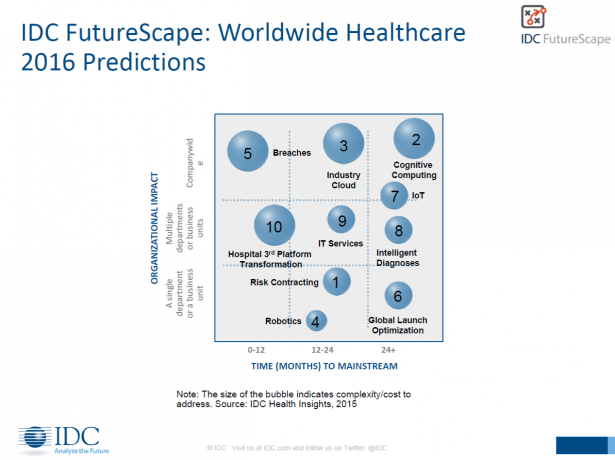10 Predictions for Healthcare IT in 2016
 Cognitive computing and virtual care are among the big IT trends that will transform healthcare delivery in the next 12-36 months, say industry analysts at IDC, a leading IT advisory firm.
Cognitive computing and virtual care are among the big IT trends that will transform healthcare delivery in the next 12-36 months, say industry analysts at IDC, a leading IT advisory firm.
The group is forecasting increased adoption of new technologies to improve diagnoses, reduce cost and mortality and personalize the patient experience.
IDC Research VP Cynthia Burghard said complex cancer care is one area that will benefit from cognitive computing solutions, such as IBM’s Watson Health initiative. Cancer centers with the funding and strategy to implement cognitive analytic solutions will be better positioned to process a high volume of data from multiple inputs, which may help a patient get the right treatment more quickly.
IDC Research Director Lynne Dunbrand said virtual care—patient visits and monitoring by video and/or internet devices—will become routine by 2018. Dunbrand said physicians can now be reimbursed for virtual visits, breaking down their resistance to these technologies. Patients are becoming much more comfortable with online video because they use it on their smartphones and home computers to communicate with family and friends, she said.
Dunbrand and IDC recently unveiled their top 10 healthcare IT industry predictions for 2016. Their list:
- Downward pressure of the healthcare economy will increase risk-based contracting to 50% of provider payments by 2017, resulting in premium increases in the 2% to 3% range.
- By 2018, industry cloud creation will be the top market entry strategy for tech providers and industrial companies, as leaders of IT and industry domain unite to tear down traditional barriers to entry.
- By 2018, physicians will use cognitive solutions to identify the most effective treatment for 50% of complex cancer patients, resulting in a 10% reduction in mortality and 10% in cost.
- By 2017, surgeons will use computer-assisted or robotic surgery techniques to assist in planning, simulating and performing 50% of the most complex surgeries.
- One out of the three individuals will have their healthcare records compromised by cyberattacks in 2016.
- By 2018, due to more frequent drug launches, pharma adoption of global launch sequence optimization solutions will grow by 50%, saving the industry billions in potential lost revenue.
- By 2018, 80% of customer/patient service interaction will make use of IoT and big data to improve quality, value and timeliness. Virtual care will become routine by 2018.
- By 2018, 30% of WW healthcare systems will employ real time cognitive analysis to provide personalized care leveraging patient's clinical data, directly supported by clinical outcomes and RWE data.
- Reluctantly, through 2017, healthcare IT services buyers will consolidate IT services spending in the hands of the five to 10 largest service providers for each sub-vertical at double industry growth rates.
- The year 2016 will see third platform acute care HIS and EHR begin to come to market, and early adopters will get started on digital transformation in 2017-2019.
The analysts noted that many of the new technologies above carry a big price tag, requiring hospitals to align business and healthcare IT strategies, and possibly even seek outside partnerships.
Finding qualified talent to implement and optimize new solutions is another persistent challenge, according to Burghard. She says healthcare, in particular, has been reluctant to pay the types of salaries required to attract and retain highly-skilled IT staff.
An on-demand webcast available from IDC offers additional insights and information.